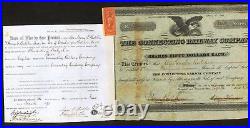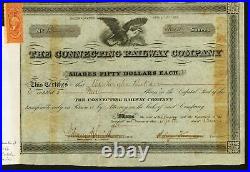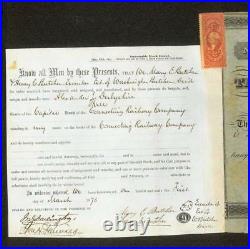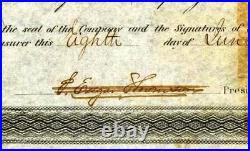




A ntique Original Vintage Stock Certificate. Thomson ONLY signed a few stocks – this is number 13 — issued in 1868 — i have only seen Two of these — to show how rare these are — i also have number 16 — it was issued in 1873 — so it took FIVE years for the company to issue 3 more stocks – the third is this Number 16 – Please see the scan — The stock looks even better than the scan. John Edgar Thomson (February 10, 1808 – May 27, 1874) was an American civil engineer. Thomson was an entrepreneur best known for his leadership of the Pennsylvania Railroad. (PRR) from 1852 until his death 1874, making it the largest business enterprise in the world and a world-class model for technological and managerial innovation. He served as PRR’s first Chief Engineer and third President. Thomson’s sober, technical, methodical, and non-ideological personality had an important influence on the Pennsylvania Railroad, which in the mid-19th century was on the technical cutting edge of rail development, while nonetheless reflecting Thomson’s personality in its conservatism and its steady growth while avoiding financial risks. His Pennsylvania Railroad was in his day the largest railroad in the world, with 6000 miles of track, and was famous for steady financial dividends, for high quality construction, constantly improving equipment, technological advances (such as replacing wood with coal as locomotive fuel), and innovation in management techniques for a large complex organization. Born in Springfield Township, Delaware County, Pennsylvania. To a family with Quaker roots that had arrived in the colonial era. His father John Thomson was a leading civil engineer, who helped build the Chesapeake and Delaware Canal. And the first experimental railroad in the United States. The son had little formal schooling, worked closely with his father from an early age, acquiring a sound foundation of engineering practice which he augmented by reading, observation, and experience. He began his railroad career at age 19 as a rodman working in a survey crew locating the Philadelphia and Columbia Railroad. And later worked for Camden and Amboy Railroad. He made an inspection tour of the new railways of Britain in 1832. Through his father’s influence he became a member of the state’s engineer corps surveying routes for a rail line west from Philadelphia. He was soon made assistant engineer, and in 1830, when the line of the Camden & Amboy Railroad was located across the state of New Jersey, Thomson was placed in charge of an engineering division. Developing Georgia’s railroads. At the age of 26 in 1834, he became the chief engineer of the newly chartered Georgia Railroad. He located the road, negotiated and oversaw construction contracts, operated portions as they opened, and promoted possible connections to the north and west. By 1845, he had completed the railroad from Augusta. At 173 miles (278.4 km), it was the longest railroad in the world at the time. Thomson later bought control of the Montgomery and West Point Railroad. And helped finance and locate the Nashville and Chattanooga Railroad. Also in 1845, he surveyed and designed the Augusta Canal. For lawyer Henry Cumming. Which was completed two years later. The state of Pennsylvania had invested heavily in state-owned canals. They were neither profitable nor efficient, and the state was falling behind its rivals. The Pennsylvania Railroad, PRR, incorporated in 1847, built a line across the mountains from Harrisburg to Pittsburgh to eliminate the inefficient Allegheny Portage Railroad and the slow-paced canals. The line would give Philadelphia a link to the fast-growing west, allowing it to compete with Baltimore (which had the Baltimore & Ohio) and New York City. Thomson did a brilliant job. With unbounded energy he sought out the best routes, making allowances for grades and river crossings. He co-designed the famous “Horseshoe Curve”. And built a road with practicable grades. The through line between Philadelphia and Pittsburgh opened for traffic in February 1854, and indeed made Philadelphia a major outlet for long-haul traffic from the west. Edgar Thomson and Herman Haupt designed the Horseshoe Curve. In the Allegheny Mountains. Of western Pennsylvania, which opened in 1854. Thomson led a faction that ousted the incumbent board in 1852; Thomson now became president and turned his attention more toward finance than engineering. He repeatedly reorganized the company into more efficient subdivisions, and to better cost accounting, paying careful attention to the selection of vice presidents. His organizational model was widely imitated by other railroads, and set the standard for large American businesses. A plaque commemorating the career of John Edgar Thomson, hanging in Philadelphia’s 30th Street Station, a former Pennsylvania Railroad Station. Thomson now expanded to the west, into Ohio and parts beyond. In 1856 he arranged for the consolidation of several western lines into the Pittsburgh, Fort Wayne & Chicago Railway. It was formally leased to the Pennsylvania in 1869 and in 1870-71 the Pennsylvania Company, one of the first of the holding companies, was created to take over the properties west of Pittsburgh which were developing into large northwest and southwest systems. Needing a connection to the port of New York, Thomson in 1871 leased 456 miles of railroad and 65 miles of canals in New Jersey. By 1873 he had links to the South, Thomson then built up Philadelphia as a transatlantic port, creating the American Steamship Company in 1870 under the control of the Pennsylvania Railroad. Steel was becoming available at moderate cost, and Thomson contracted with Andrew Carnegie. For steel to replace all the wooden railway bridges, and to replace iron tracks with stronger steel tracks. The result was heavier, faster, more efficient trains. In 1860, the Pennsylvania represented only the main line from Philadelphia to Pittsburgh, with a few short branches. By 1869 it had expanded within Pennsylvania alone to nearly one thousand miles and also controlled lines northward to the shores of Lake Erie, through New York. In 1870 the Pennsylvania began to expand on the east also and obtained an entry into New York City by acquiring the United Railroad and Canal Company, which owned lines across New Jersey. It bought the Cleveland and Pittsburgh Railroad in 1871 as well as smaller lines in Ohio, merging them into the system. Louis, with lines extending westward from Pittsburgh to St. Louis, with branches reaching southward to Cincinnati and northward to Chicago. This system included over 1400 miles of road, giving the Pennsylvania a second line to Chicago, a direct line to St. Louis, a second line to Cincinnati, and access to territory not previously tapped. This item is in the category “Coins & Paper Money\Stocks & Bonds, Scripophily\Transportation\Railroads”. The seller is “jaygould” and is located in this country: US. This item can be shipped worldwide.
